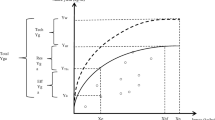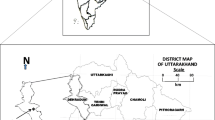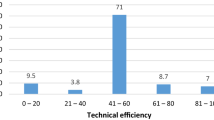Abstract
Fars has a special place in Iran in terms of natural resources and diverse climate aiming this province to increase production of major crops such as corns. In light of increasing domestic production and preventing yield loss of maize, many farmers utilize high quantities of pesticides, chemical fertilizers and over-extract groundwater without considering immediate and long-term consequences of such operations on environment. The main purpose of this study is to investigate technical efficiency and sustainability–technology gap ratio (STGR) of maize producers by agricultural sustainability in Fars province in Iran. Technical efficiency is considered as a key element among the triple elements of sustainable development (economic, social and ecological). Applying model of agricultural sustainability and compromise programming method, regions were classified into three groups (sustainable, relatively sustainable and unsustainable), and data were collected interviewing a total of 300 farmers in 2008–2009 from Kazerun, Firouzabad and Marvdasht chosen randomly and systematically as representatives of these three groups. Technical efficiencies and STGRs were calculated for the regions applying stochastic production frontier, regional stochastic frontier functions and the metafrontier. The results indicate that assuming the same technology between the fields (traditional methods) leads to overestimation of technical efficiency. Mean STGRs in Marvdasht, Firouzabad and Kazerun were found to be 59.3, 71.1 and 68.9, respectively. This suggests that technical efficiency and STGR of relatively sustainable regions are higher than those of the unsustainable regions. Thus, farmers in these areas can reduce gap between technology and agricultural sustainability levels via achieving metatechnology that is compatible with sustainable agriculture.


Similar content being viewed by others
Notes
In this study, four weight groups were used for each indicator.
The Divisia index is calculated as: \(Xi4(k) = \prod\nolimits_{j = 1}^{6} {p_{ij(k)}^{{\alpha_{ij} }} }\) where i = 1, 2,…, N k ; α ij(k) denotes share of jth input in variable cost for the ith farm in the kth group; P i1(k) denotes the cost of labor (in toman); P i2(k) denotes the cost of irrigation (toman); P i3(k) denotes the cost of pesticides (toman); P i4(k) denotes the cost of animal fertilizer (toman); P i5(k) denotes the total cost of machinery(toman); P i6(k) denotes other cost (toman) for the ith farm in the kth group.
First group is recognized as sustainable region and includes Abadeh, Kazerun, Lamerd and Mamasani. Second group includes Arsanjan, Darab, Eqlid, Fasa, Firouzabad and Lar and is categorized as relatively sustainable, and the third group includes Estahban, Jahrom, Marvdasht and Shiraz and is realized as unsustainable.
The LR statistic is given by \(\lambda = - 2\left[ {\ln (L(H_{0} )/L(H_{1} ))} \right] = - 2\left[ {\ln (L(H_{0} )) - \ln (L(H_{1} ))} \right],\) where ln[L(H 0) is value of likelihood function under H 0. The results of each model are detailed in Table 5.
References
Abay, C., Miran, B., & Gunden, B. (2004). An analysis of input use efficiency in tobacco production with respect to sustainability: The case study of Turkey. Journal of Sustainable Agriculture, 24, 123–143.
Ahmad, M., Chaudhry, G. M., & Iqbal, M. (2002). Wheat productivity, efficiency, and sustainability: A stochastic production frontier analysis. The Pakistan development review, 41(4 part II), 643–663.
Aigner, D., Lovell, C. A. K., & Schmidt, P. (1977). Formulation and estimation of stochastic frontier production function models. Journal of Econometrics, 6, 21–37.
Baja, S., Chapman, D. M., & Dragovich, D. (2007). Spatial based compromise programming for multiple criteria decision making in land use planning. Environmental Modeling and Assessment, 12, 171–184.
Battese, G. E., & Coelli, T. (1995). A model for technical inefficiency effects in a stochastic frontier production function for panel data. Empirical Economics, 20, 325–332.
Battese, J., & Rao, D. S. P. (2002). Technology gap, efficiency and a stochastic metafrontier function. International Journal of Business & Economic, 1, 87–93.
Battese, G. E., Rao, D. S. P., & O’Donnell, C. J. (2004). A metafrontier production function for estimation of technical efficiencies and technology gaps for firms operating under different technologies. Journal of Productivity Analysis, 21, 91–103.
Berroteran, J. L., & Zinck, J. A. (1997). Indicators of agricultural sustainability at national level. A case study of Venezuela. ITC-Journal 1997-3/4, ITC, Enschede, The Netherland, CD-ROM, p. 28.
Chen, Z., & Song, S. (2008). Efficiency and technology gap in China’s agriculture: A regional meta-frontier analysis. China Economic Review, 19, 287–296. doi:10.1016/j.chieco.2007.03.001.
Clark, W. C., & Dickson, N. M. (2003). Sustainability science, the emerging research program. Proceedings of the National Academy of Sciences of the United States of America, 100, 8059–8061.
Coelli, T. J. (1996) A guide to FRONTIER version 4.1: A computer program for stochastic frontier production and cost function estimation. CEPA Working Papers. No. 7/96, Department of econometrics, University of New England, Armidale.
Cornelissen, A. M. G. (2003). Two faces of sustainability. Fuzzy evaluation of sustainable development. Dissertation, University of Wageningen.
Cornelissen, A. M. G., van den Berg, J., Koops, W. J., Grossman, M., & Udo, H. M. J. (2001). Assessment of the contribution of sustainability indicators to sustainable development: A novel approach using fuzzy set theory. Agriculture, Ecosystems & Environment, 86, 173–185.
De Koeijer, T. J., Wossink, G. A. A., Struik, P. C., & Renkema, L. A. (2002). Measuring agricultural sustainability in terms of efficiency: The case of Dutch sugar beet growers. Journal of Environmental Management, 66, 9–17.
De Koeijer, T. J., Wossink, G. A. A., Van Ittersum, M. K., & Struik, P. C. (1999). A conceptual model for analyzing input-out coefficients in arable farming systems: From diagnosis towards design. Agricultural Systems, 61, 33–44.
Diaz-Balteiro, L., Voces, R., & Romero, C. (2011). Making sustainability rankings using compromise programming. An application to European paper industry. Silva Fennica, 45(4), 761–773.
Farshad, A., & Zinck, J. A. (2001). Assessing agricultural sustainability using the six pillar models: Iran as a case study. In S. R. Gliessman (Ed.), Agroecosystem sustainability. Boca Raton: CRC Press.
Food and Agriculture Organization of the United Nations (FAO). (2005). FAOSTAT, the FAO statistical database. http://faostate.fao.org.
Gomes, E. G., Soares, J. C. C. B., De Mello, G. S., Souza, E., Angulo Meza, L., & Mabgaberia, J. A. C. (2008). Efficiency and sustainability assessment for a group of farmers in the Brazilian Amazon. Annals of Operations Research,. doi:10.1007/s10479-008-0390-6.
Hartwick, J., & Olewiler, N. (1988). The economics of natural resource use (2nd ed.). Reading: Addison-Wesley.
Harwood, R. R. (1998). Sustainability in agricultural systems in transition—At what cost? Keynote address, workshop on sustainability of agricultural systems in transition. Baltimore, USA: ASA, CSSA, SSSA and the World Bank.
Hazell, P., & Wood, S. (2008). Drivers of change in global agriculture. Philosophical Transactions of Royal Society, 363, 495–515.
Lara, P., & Stancu-Minasian, I. (1999). Fractional programming: A tool for the assessment of sustainability. Agricultural Systems, 62(2), 131–141.
Manoloadis, O. G. (2002). Development of ecological indicators—A methodological framework using compromise programming. Ecological Indicators, 2, 169–176.
Meeusen, W., & Van Den Broeck, J. (1977). Efficiency estimation form Cobb–Douglas production function with composed error. International Economic Review, 18, 435–444.
Mehrabi Boshrabadi, H., Villano, R., & Fleming, E. (2008). Technical efficiency and environmental-technological gaps in wheat production in Kerman province of Iran: A meta frontier analysis. Agricultural Economics, 38(1), 67–76.
Moreira, V. H., & Bravo-Ureta, B. E. (2010). Technical efficiency and metatechnology ratios for dairy farms in three southern cone countries: A stochastic meta-frontier model. Journal of Productivity Analysis, 33, 33–45.
Mulder, K., Ferrer, D., & Lente, H. V. (2011). What is Sustainable technology? Perceptions, paradoxes and possibilities. Greenleaf Publishing, p. 6.
Munasinghe, M., (1993). Environmental economics and sustainable development. World Bank, Environmental Paper Number 3.
O’Donnell, C. J., Rao, D. S. P., & Battese, G. E. (2008). Metafrontier frameworks for the study of firm-level efficiencies and technology ratios. Empirical Economics, 4, 231–255. doi:10.1007/s00181-007-0119-4.
Pannell, D. J., & Glenn, N. A. (2000). A framework for the economic evaluation and selection of sustainability indicators in agriculture. Ecological Economics, 33, 135–149.
Pannell, D. J., & Schillizi, S. (1999). Sustainable agriculture: A matter of ecology, equity, economic efficiency or expedience? Journal of Sustainable Agriculture, 13, 57–66.
Piot-Lepetit, I., Vermersch, D., & Weaver, R. D. (1997). Agriculture’s environmental externalities: DEA evidence for French agriculture. Applied Economics, 29, 331–338.
Prato, T. (2009). Fuzzy adaptive management of social and ecological carrying capacities for protected areas. Journal of Environmental Management, 90, 2551–2557.
Rahimi Soreh, S., & Sadeghi, H. (2004). Efficiency and scale economics of range management projects by parametric and non-parametric approaches. Economic research, 67, 259–291.
Rao, D. S. P., O’Donnelland, C. J. & Battese, G. (2003). Metafrontier functions for the study of inter-regional productivity differences centre for efficiency and Productivity analysis. School of economics, University of Queensland, Australia, Working Paper Series No. 01/2003.
Rao, N. H., & Rogers, P. P. (2006). Assessment of agricultural sustainability. Current Science, 91(4), 439–448.
Reinhard, S., Knox Lovell, C. A., & Thijssen, G. (2000). Environmental efficiency with multiple environmentally detrimental variables; estimated with SFA and DEA. European Journal of Operational Research, 121, 287–303.
Romero, C., Rehman, T., & Domingo, J. (1987). Compromise-risk programming for agricultural resource allocation problems. Journal of Agricultural Economics, 39, 271–276.
Rosta, K., & Sedeghi, H. (2003). An investigation of the determinations of farmers’ technical knowledge as related to sustainable in Fars province. Iranian Journal of Agriculture Science, 34(4), 913–923.
Sattler, C., Nagel, U. J., Werner, A., & Zander, P. (2010). Integrated assessment of agricultural production practices to enhance sustainable development in agricultural landscapes. Ecological Indicators, 10, 49–61.
Sattler, C., Stachow, U., & Berger, G. (2012). Expert knowledge-based assessment of farming practices for different biotic indicators using fuzzy logic. Journal of Environmental Management, 95, 132–143.
Sauer, J., & Abdallah, M. J. (2007). Forest diversity, tobacco production and resource management in Tanzania. Forest Policy and Economics, 9, 421–439.
Senanayake, R. (1991). Sustainable agriculture: Definitions and parameters for measurement. Journal of Sustainable Agriculture, 1(4), 7–28.
Shannon, C. E., & Wiener, W. (1963). The mathematical theory of communication (pp. 1–117). Urbana: University Illinois Press.
Smith, C. S., & McDonald, G. T. (1998). Assessing the sustainability of agriculture at planning stage. Journal of Environmental Management, 52, 15–37.
Smyth, A., & Dumanski, J. (1993). FESLM: An international framework for evaluating sustainable land management. FAO, World Soil Resources Report 3. Rome, Italy.
Voces, R., Diaz-Balteiro, L., & Romero, C. (2010). In search of a European paper industry ranking in terms of sustainability by using binary goal programming. Lecture Notes in Economics and Mathematical Systems, 638, 141–149.
Zinck, J. A., Berroteran, J. L., Farshad, A., Moameni, A., Wokabi, S., & Van Ranst, E. (2002). Approaches to assessing sustainable agriculture. Ciencia Del Sueli, 20(2), 55–68.
Author information
Authors and Affiliations
Corresponding author
Rights and permissions
About this article
Cite this article
Pourzand, F., Bakhshoodeh, M. Technical efficiency and agricultural sustainability–technology gap of maize producers in Fars province of Iran. Environ Dev Sustain 16, 671–688 (2014). https://doi.org/10.1007/s10668-013-9501-x
Received:
Accepted:
Published:
Issue Date:
DOI: https://doi.org/10.1007/s10668-013-9501-x




